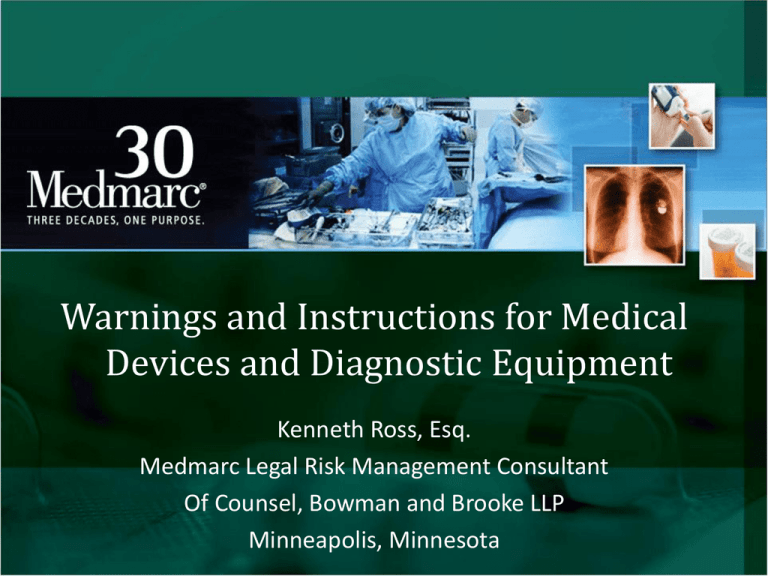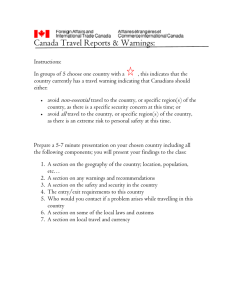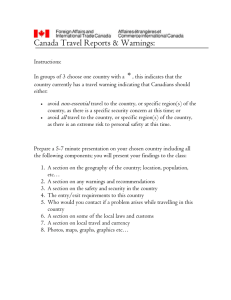Warnings and Instructions for Medical Devices and
advertisement

Warnings and Instructions for Medical Devices and Diagnostic Equipment Kenneth Ross, Esq. Medmarc Legal Risk Management Consultant Of Counsel, Bowman and Brooke LLP Minneapolis, Minnesota Product Liability Liability of a manufacturer or someone else in the chain of production and distribution for personal injury, property damage, or possibly economic loss caused by the sale or use of a product. 2 What Can Create Liability Catalog Data Website Service Manual Sales Brochure Advertising Owner’s Manual Labels PRODUCT Warranty Package inserts Service Installation Manual Spare Parts Installation Training 3 Who Can Create Liability Nurse Doctor Serviceman Home Caregiver Installer Dr. Articles Textbooks Salesman PRODUCT Distributor FDA Dealer Spare Rental company Parts Component mfger OEM 4 Legal requirements for device and diagnostic equipment warnings and instructions Common law (judges and juries) State courts Federal courts Regulatory law (Congress and FDA) U.S. Codes Code of Federal Regulations FDA Guidances and Recommendations Voluntary consensus standards (ANSI, IEC, ISO, AAMI) 5 Common Law 6 Is compliance with FDA legal requirements a good defense in a product liability case? No pre-emption for 510(k) devices Pre-emption exists for PMA devices, but that could change Congress is against pre-emption Mere compliance may not be enough Government requirements are a minimum, not a maximum Liability if non-compliance “caused” the injury or damage. In other words, liable if compliance would have prevented the incident. 7 Is compliance with voluntary standards a good defense in a product liability case? Not under common law. Standards are a minimum, not a maximum. But, good evidence of adequacy. However, not an absolute defense. Liability if non-compliance “caused” the injury or damage. In other words, liable if compliance would have prevented the incident. 8 Safety Hierarchy - Rest. 3d “…when a safer design can reasonably be implemented and risks can reasonably be designed out of a product, adoption of the safer design is required over a warning that leaves a significant residuum of such risks.” 9 Safety Hierarchy Eliminate hazard and risk from design Add guard, barrier, or interlock Add safety labels Provide for training and instruction Recommend personal protection 10 Definitions Warnings alert users and consumers to the existence and nature of product risks so that they can prevent harm either by appropriate conduct during use or consumption or by choosing not to use or consume the product. Instructions inform persons how to use and consume products safely. 11 Warnings Must Be Provided If . . . The product is hazardous The manufacturer knows or should know the product is hazardous The hazard is not obvious to the user The hazard will exist during reasonably foreseeable use or misuse 12 Obvious Hazards Warning not required for obvious hazard Because product user will or should already know of its existence. Not necessary, diminish impact of other warnings. Decided by trier of fact Related to reasonably foreseeable Probability and severity also obvious 13 Who has to be warned and instructed? Patient* Home healthcare provider Parent Doctor Nurse Healthcare professional Service Technician Bystander * Affected by “learned intermediary doctrine” 14 What is an adequate warning? It is in a form that could reasonably be expected to catch the attention of a reasonably prudent person in the circumstances of the product’s use; The content is of such a nature as to be comprehensible to the average user; and It conveys a fair indication of the nature and extent of the danger to the mind of a reasonably prudent person Warning’s adequacy impacted by sophisticated user defense. Warning does not have to be effective to be adequate. 15 Content of adequate warning Description of hazard Probability of hazard occurring Severity if occurs How to avoid hazard 16 U.S. Law re Instructions A court has held that warnings, standing alone, may have no practical relevance without instructions and that instructions without warnings may not be adequate. In discussing the adequacy of instructions, the cases only say that manuals should be “adequate, accurate and effective” and “clear, complete and adequately communicated.” Whether warning goes on product or in manual is decided on a case by case basis 17 Regulatory Law 18 Design FDA requires that product be safe and effective and considers design as well as adequacy of “directions for use and warnings against unsafe use.” 19 FDA: Warnings and Instructions 21 CFR 820 provides general requirements for labeling Guidance on Medical Device Patient Labeling (2001) FDA Quality System Manual – Chapter 11 (1996) Device Labeling Guidance - #G91-1 (1991) 20 FDA: Warnings and Instructions Labeling: Regulatory Requirements for Medical Devices (1989) Human Factors Principles for Medical Device Labeling (1993) Write It Right: Recommendations for Developing User Instruction Manuals for Medical Devices Used in Home Health Care (1993) 21 FDA: Warnings and Instructions Writing Dear Doctor Letters for Recalls of ICDs (2007) Guidance: Presenting Risk Information in Prescription Drug and Medical Device Promotion (2009) 22 Writing Dear Doctor Letters for Recalls of ICDs (2007) Present safety information in consistent order Format for easy readability Include Nature of malfunction Scope or likelihood of problem Severity Recommended treatment 23 Voluntary Consensus Standards 24 FDA approach* Compliance with recognized consensus standards is voluntary However, compliance can be used to show that device is safe and effective There are situations where standard doesn’t address all safety aspects and therefore is not dispositive FDA maintains a database on recognized consensus standards *FDA Guidance on Recognition and Use of Consensus Standards (2007) 25 Voluntary Standards (Common law) Compliance with standards is generally not required; however, Certain FDA laws may require compliance Failure to comply may have to be explained away in court Could be proof of state of the art May need to exceed standards 26 Labeling Standards U.S. ANSI Z535 (all products where no product specific standard applies) IEC 60601 (medical devices) EN 1041 Europe ISO 3864 (all products except chemicals and where law requires different label) Product specific European Directives 27 Label elements Signal word – Danger, Warning or Caution Description of hazard Description of consequences (severity) Description of probability How to avoid (precautions) 28 Z535 Signal Words (ANSI Z535.4) Danger – will cause serious injury or death Warning – could cause serious injury or death Caution – will or could cause moderate or minor injury and property damage NOTICE – property damage only. 29 30 ISO 3864 31 Grouped Safety Messages (ANSI Z535.6) Heading indicates safety-related information Sub-headings allow easy navigation Supplemental directive Safety messages apply to entire document All caps only used for brief emphasis only No Z535.4-style formatting for each message Safety symbols 32 State Of The Art Instructions Label on product referring to manual Incorporate safety information into manual Warning on cover to read manual Safety information consistent with labels, ads Reproduce labels in product manual Written for intended audience Delivered to customer 33 High-tech ways to warn and instruct Interactive CDs and websites Readouts on LED screens DVDs Computer software In-service training Testing comprehension Part of usability testing Recommended in Write it Right Informal focus groups versus more formal testing 34 Contact information kenrossesq@comcast.net 952-933-1195 www.productliabilityprevention.com https://www.medmarc.com/WhatWeOffer/Lo ssControl/Pages/WarningsInstructions.aspx 35




